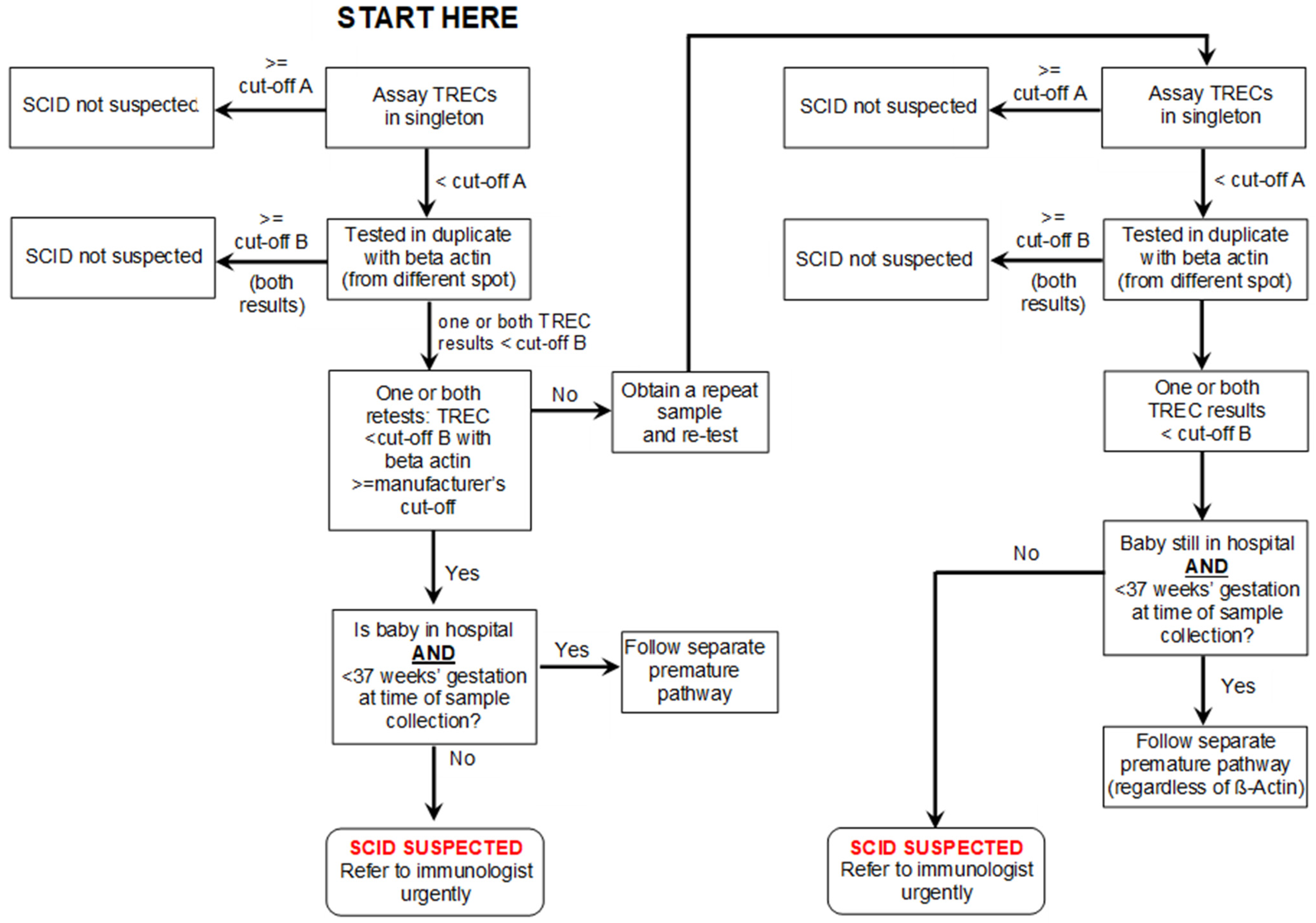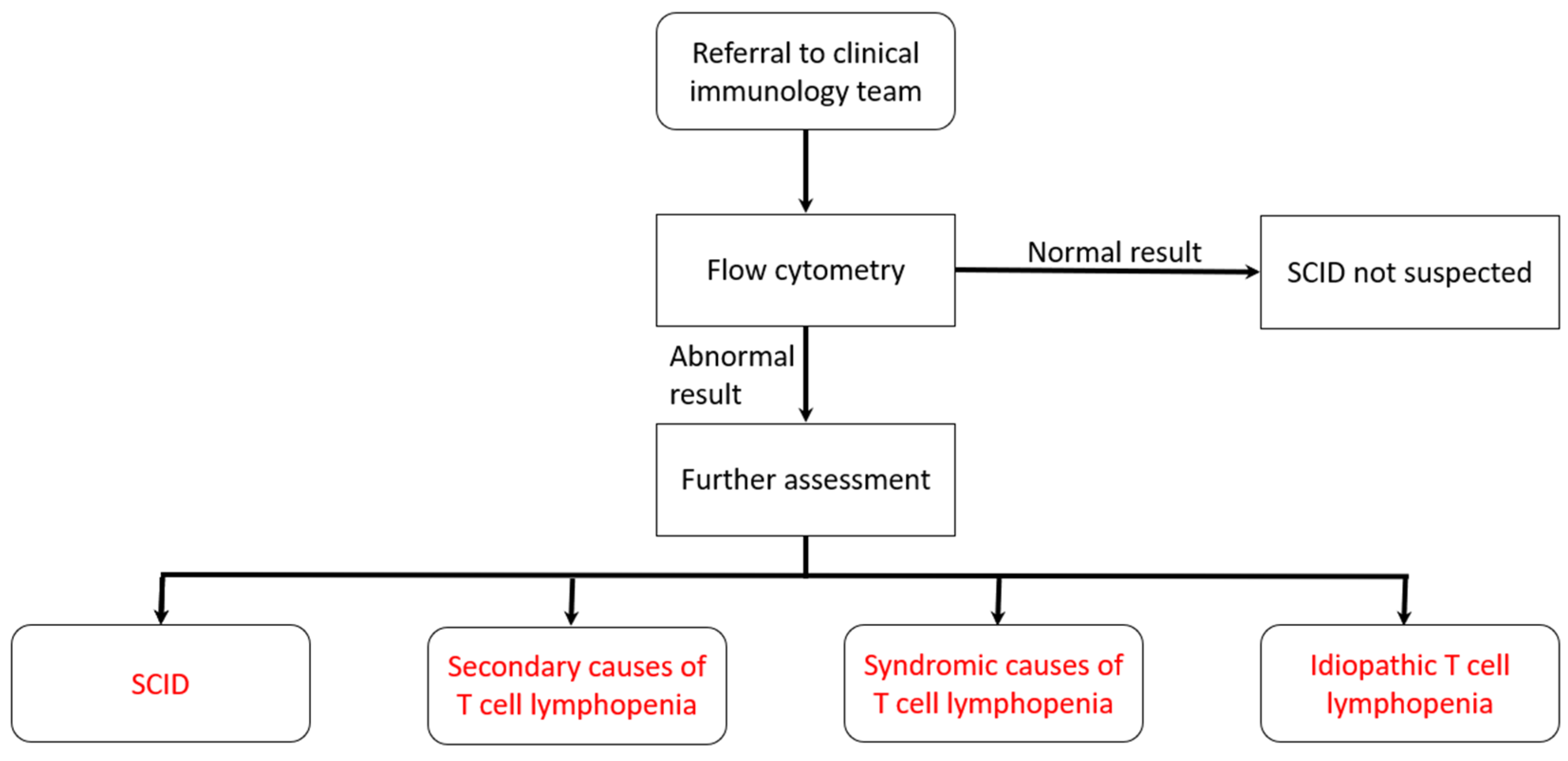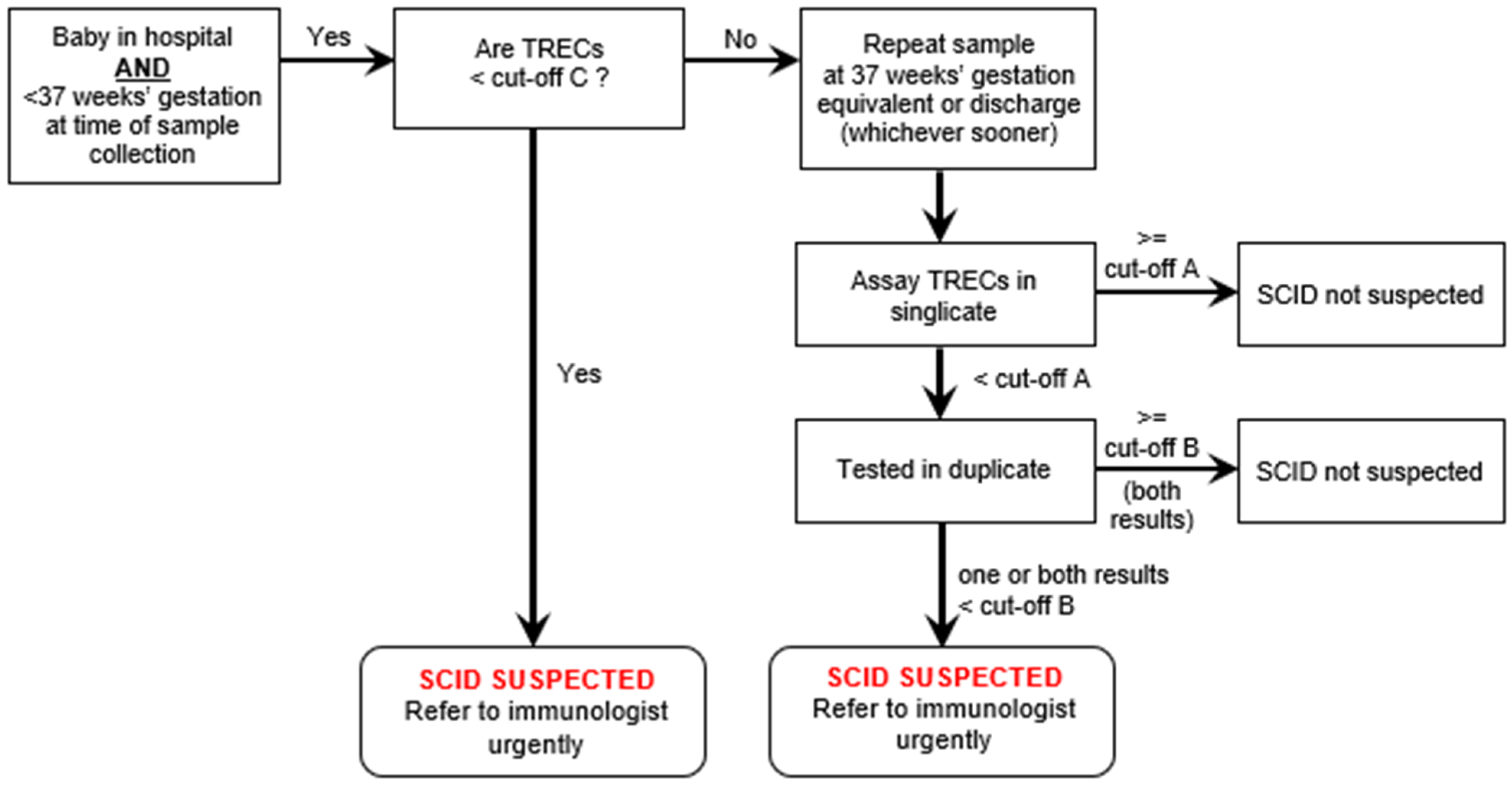Study Design for an Evaluation of Newborn Screening for SCID in the UK
Abstract
:1. Introduction
- the cost of the TREC assay;
- the incidence of SCID;
- post-HSCT mortality rates in the early diagnosed population;
- the length of stay in hospital of the early diagnosed SCID patients;
- the proportion detected by family history in the absence of screening.
- alternative assays for TRECs;
- number of babies who have low TRECs, but normal flow cytometry (false positives);
- the effect on the families of these babies;
- the desirability, or not, of a separate pathway for premature babies;
- the number of babies who have an abnormal assessment on flow cytometry and the categories of conditions detected;
- the extent of the benefit for babies with SCID;
- the extent of the benefit, if any, for babies with other conditions, particularly idiopathic T-cell lymphopenia.
2. Materials and Methods
2.1. Pre-Evaluation Laboratory Work
2.2. Prematurity
2.3. Clinical Pathways for Those Who Have Abnormal Flow Cytometry
2.4. SCID Screening and Vaccination
2.5. The Patient/Family Experience
2.6. Information for Professionals
2.7. Data Collection
2.7.1. Clinical Data
2.7.2. Resource Usage
3. Conclusions
Funding
Acknowledgments
Conflicts of Interest
References
- van der Spek, J.; Groenwold, R.H.; van der Burg, M.; van Montfrans, J.M. TREC Based Newborn Screening for Severe Combined Immunodeficiency Disease: A Systematic Review. J. Clin. Immunol. 2015, 35, 416–430. [Google Scholar] [CrossRef] [PubMed] [Green Version]
- Routes, J.M.; Grossman, W.J.; Verbsky, J.; Laessig, R.H.; Hoffman, G.L.; Brokopp, C.D.; Baker, M.W. Statewide newborn screening for severe T-cell lymphopenia. JAMA 2009, 302, 2465–2470. [Google Scholar] [CrossRef] [PubMed] [Green Version]
- Quinn, J.; Orange, J.S.; Modell, V.; Modell, F. The case for severe combined immunodeficiency (SCID) and T-cell lymphopenia newborn screening: Saving lives …one at a time. Immunol. Res. 2020, 68, 48–53. [Google Scholar] [CrossRef] [PubMed]
- UK National Screening Committee. About Us. Available online: https://www.gov.uk/government/organisations/uk-national-screening-committee/about (accessed on 29 November 2021).
- UK National Screening Committee. Evidence Review Criteria: National Screening Programmes. 23 October 2015. Available online: https://www.gov.uk/government/publications/evidence-review-criteria-national-screening-programmes (accessed on 29 November 2021).
- Wilson, J.; Jungner, G. Principles and practice of screening for disease. In Public Health Papers 34; World Health Organization: Paris, France, 1968. [Google Scholar]
- UK National Screening Committee. Note of the Meeting Held on 23 June 2017. pp. 15–17. Available online: https://drive.google.com/drive/folders/0B8eopFA9myQefk9EalVQLWs5RlFBSmlUdzNvaUxuS2FhdWV2VWJaSTZ2YXlTdVZDYXdyNDA?resourcekey=0-tt4Y5qA3_0DFLrnaJn6xxQ (accessed on 29 November 2021).
- UK National Screening Committee. Note of the meeting held on 25 October 2017. pp. 14–15. Available online: https://drive.google.com/drive/folders/0B8eopFA9myQefk9EalVQLWs5RlFBSmlUdzNvaUxuS2FhdWV2VWJaSTZ2YXlTdVZDYXdyNDA?resourcekey=0-tt4Y5qA3_0DFLrnaJn6xxQ (accessed on 29 November 2021).
- Bessey, A.; Chilcott, J.; Leaviss, J.; De La Cruz, C.; Wong, R. A Cost-Effectiveness Analysis of Newborn Screening for Severe Combined Immunodeficiency in the UK. Int. J. Neonatal Screen 2019, 30, 28. [Google Scholar] [CrossRef] [PubMed] [Green Version]
- Public Health England. Clinical Pathway for Babies Who Screen Positive for SCID. 27 August 2021. Available online: https://www.gov.uk/government/publications/clinical-pathway-for-babies-who-screen-positive-for-scid (accessed on 29 November 2021).
- UK Health Security Agency. Tuberculosis. In Immunisation against Infectious Disease; The Stationery Office: London, UK, Last Updated August 2018. Available online: https://www.gov.uk/government/publications/tuberculosis-the-green-book-chapter-32 (accessed on 29 November 2021).
- Fekrvand, S.; Yazdani, R.; Olbrich, P.; Gennery, A.; Rosenzweig, S.D.; Condino-Neto, A.; Azizi, G.; Rafiemanesh, H.; Hassanpour, G.; Rezaei, N.; et al. Primary Immunodeficiency Diseases and Bacillus Calmette-Guérin (BCG)-Vaccine-Derived Complications: A Systematic Review. Allergy Clin. Immunol. Pract. 2020, 8, 1371–1386. [Google Scholar] [CrossRef] [PubMed]
- Marciano, B.E.; Huang, C.-Y.; Joshi, G.; Rezaei, N.; Carvalho, B.C.; Allwood, Z.; Ikinciogullari, A.; Reda, S.M.; Gennery, A.; Thon, V.; et al. BCG vaccination in patients with severe combined immunodeficiency: Complications, risks, and vaccination policies. J. Allergy Clin. Immunol. 2014, 133, 1134–1141. [Google Scholar] [CrossRef] [PubMed] [Green Version]
- Public Health Agency of Sweden. Vaccination Programmes. Available online: https://www.folkhalsomyndigheten.se/the-public-health-agency-of-sweden/communicable-disease-control/vaccinations/vaccination-programmes/ (accessed on 29 November 2021).
- Chien, Y.-H.; Yu, H.-H.; Lee, N.-C.; Ho, H.-C.; Kao, S.-M.; Lu, M.-Y.; Jaing, T.-H.; Lee, W.-I.; Chang, K.-W.; Shieh, C.-C.; et al. Newborn Screening for Severe Combined Immunodeficiency in Taiwan. Int. J. Neonatal Screen 2017, 3, 16. [Google Scholar] [CrossRef]
- Norwegian Institute of Public Health. Vaccine against Tuberculosis (BCG). Available online: https://www.fhi.no/en/id/vaccines/childhood-immunisation-programme/vaccines-in-CIP/vaccine-against-tuberculosis/ (accessed on 24 January 2020).
- Australian Government. Department of Health. Australian Immunisation Handbook. Available online: https://immunisationhandbook.health.gov.au/vaccine-preventable-diseases/tuberculosis (accessed on 29 November 2021).
- New Zealand Ministry of Health. Immunisation Handbook 2020. 21. Tuberculosis. Available online: https://www.health.govt.nz/our-work/immunisation-handbook-2020/21-tuberculosis (accessed on 29 November 2021).
- Joint Committee on Vaccination and Immunisation. Minute of Meeting held on 4 and 5 February 2020. Department of Health and Social Security. Available online: https://app.box.com/s/iddfb4ppwkmtjusir2tc/file/636396626894 (accessed on 29 November 2021).
- PHE Screening. Launch of New NHS SCID Screening Resources for Parents and Professionals. Available online: https://phescreening.blog.gov.uk/2021/08/11/launch-of-new-nhs-scid-screening-resources-for-parents-and-professionals (accessed on 29 November 2021).
- Mantravadi, V.; Bednarski, J.J.; Ritter, M.A. Immunological Findings and Clinical Outcomes of Infants with Positive Newborn Screening for Severe Combined Immunodeficiency from a Tertiary Care Centre in the U.S. Front Immunol. 2021, 12, 734096. [Google Scholar] [CrossRef] [PubMed]
- Course, C.W.; Hanks, R. Newborn screening for cystic fibrosis: Is there benefit for everyone? Paediatr. Respir Rev. 2019, 31, 3–5. [Google Scholar] [CrossRef] [PubMed]
- PHE Screening. Evaluation Launches of Newborn Screening for SCID in the NHS. 6 September 2021. Available online: https://phescreening.blog.gov.uk/tag/scid (accessed on 29 November 2021).



| Perkin Elmer EnLite TM (Copies/μL) | Immuno IVD SPOT-It TM (Copies/Punch) | ||
|---|---|---|---|
| TRECs | A | 30 | 12.0 |
| B | 20 | 8.0 | |
| C * | 8 | 4.0 | |
| β-Actin | 53 | 1000 |
Publisher’s Note: MDPI stays neutral with regard to jurisdictional claims in published maps and institutional affiliations. |
© 2022 by the author. Licensee MDPI, Basel, Switzerland. This article is an open access article distributed under the terms and conditions of the Creative Commons Attribution (CC BY) license (https://creativecommons.org/licenses/by/4.0/).
Share and Cite
Elliman, D. Study Design for an Evaluation of Newborn Screening for SCID in the UK. Int. J. Neonatal Screen. 2022, 8, 4. https://doi.org/10.3390/ijns8010004
Elliman D. Study Design for an Evaluation of Newborn Screening for SCID in the UK. International Journal of Neonatal Screening. 2022; 8(1):4. https://doi.org/10.3390/ijns8010004
Chicago/Turabian StyleElliman, David. 2022. "Study Design for an Evaluation of Newborn Screening for SCID in the UK" International Journal of Neonatal Screening 8, no. 1: 4. https://doi.org/10.3390/ijns8010004
APA StyleElliman, D. (2022). Study Design for an Evaluation of Newborn Screening for SCID in the UK. International Journal of Neonatal Screening, 8(1), 4. https://doi.org/10.3390/ijns8010004





